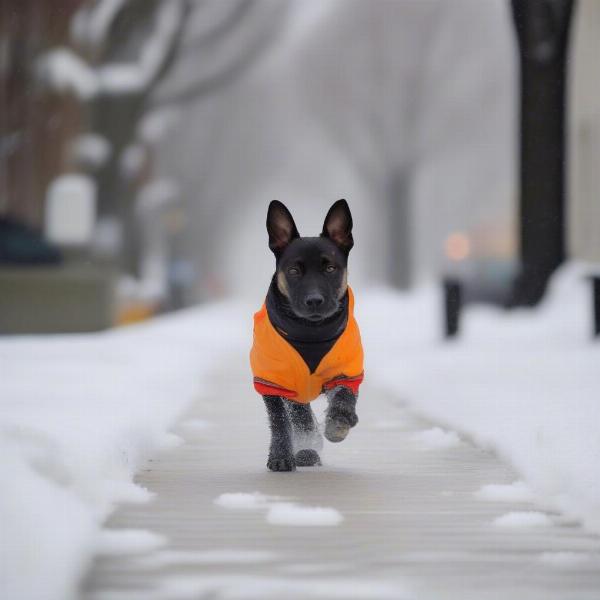A dog paw cut between the toes can be a surprisingly common and painful injury. Whether your furry friend stepped on a sharp object during a walk or has an irritating growth, understanding the causes, treatment, and prevention of these interdigital injuries is crucial for every dog owner. This guide will equip you with the knowledge you need to care for your dog’s paws and ensure their comfort and well-being.
Identifying and Understanding Interdigital Cuts
Interdigital cuts, as the name suggests, are cuts or lacerations located in the webbing between a dog’s toes. They can range from minor scrapes to deeper wounds that may require veterinary attention. These injuries can be caused by various factors, including sharp objects like glass or thorns, rough terrain, excessive licking or chewing due to allergies or irritations, and underlying medical conditions like interdigital cysts or tumors. Recognizing the signs of a paw cut is the first step in providing appropriate care. These signs can include limping, excessive licking of the paw, visible bleeding, redness, swelling, and sensitivity to touch.
Treating a Dog Paw Cut at Home
For minor cuts, you can often provide first aid at home. Start by gently cleaning the affected area with warm water and a mild antiseptic solution. Avoid using hydrogen peroxide, as it can damage healthy tissue. Pat the area dry with a clean towel and apply a pet-safe antiseptic ointment. If the cut is small and not bleeding heavily, you can leave it uncovered to air dry. For larger cuts or those that continue to bleed, apply a clean bandage to protect the wound and prevent further contamination. dog paw salve can be helpful in soothing and protecting the paw.
When to Seek Veterinary Care
While minor cuts can be treated at home, some situations warrant a visit to the veterinarian. Deep cuts, wounds that are heavily contaminated, injuries accompanied by significant pain or swelling, and cuts that show signs of infection (such as pus, increased redness, or a foul odor) should be evaluated by a professional. Additionally, if your dog is excessively licking the paw or if the cut doesn’t seem to be healing within a few days, veterinary attention is necessary. Your veterinarian can properly clean and dress the wound, prescribe antibiotics if needed, and address any underlying medical conditions that may be contributing to the problem.
What will the vet do for a cut paw?
Your vet will likely clean the wound thoroughly, potentially clip the hair around the area for a better view and to prevent matting, and may stitch the cut if it’s deep. They may also prescribe antibiotics or pain medication.
Preventing Interdigital Cuts
 Chó mang ủng
Chó mang ủng
Preventing paw injuries is always the best approach. Regularly check your dog’s paws for any signs of cuts, abrasions, or foreign objects. Keep your dog’s nails trimmed to prevent them from catching and tearing. Avoid walking your dog in areas with sharp debris, such as broken glass or thorny bushes. Consider using dog boots for winter or in hazardous environments. If your dog has allergies or tends to lick their paws excessively, address the underlying cause with your veterinarian. Providing appropriate enrichment and mental stimulation can also help reduce boredom-related licking and chewing.
Conclusion
Taking care of your dog’s paws is essential for their overall health and well-being. By understanding the causes, treatment, and prevention of dog paw cuts between toes, you can ensure that your furry friend stays happy, healthy, and ready for any adventure. Regular paw checks, prompt treatment, and proactive preventive measures can significantly reduce the risk of these painful injuries.
FAQs
- How long does it take for a dog paw cut to heal? Minor cuts typically heal within a week or two. Deeper wounds may take longer.
- Can I use Neosporin on my dog’s paw? While some forms of Neosporin are considered safe for dogs, it’s best to consult your veterinarian before applying any human medication.
- Why is my dog constantly licking their paws? Excessive licking can be a sign of allergies, parasites, infections, or boredom.
- What are the signs of an infected paw cut? Signs of infection include increased redness, swelling, pus, a foul odor, and pain.
- Are there any home remedies for dog paw cuts? Soaking the paw in warm Epsom salt solution can help soothe minor irritation and promote healing. rocket dog winter snow boots are great for protecting paws in harsh weather.
- How can I stop my dog from licking their paw cut? Using an Elizabethan collar (cone) can prevent your dog from accessing the wound.
- Should I bandage my dog’s paw cut? Bandaging is recommended for larger cuts or those that continue to bleed, but always consult your vet for advice.
Related Articles:
About ILM Dog:
ILM Dog is your trusted international resource for expert advice on all aspects of dog care, from breed selection and puppy care to senior dog health and training. We offer comprehensive guides and practical tips to help you provide the best possible care for your canine companion. Whether you’re a seasoned dog owner or just starting your journey, we’re here to support you every step of the way. Contact us at [email protected] or +44 20-3965-8624 for personalized advice.